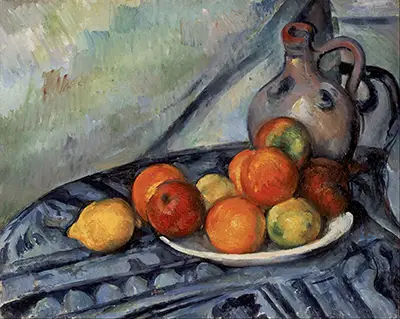Some of Cézanne's most famous and celebrated paintings fall into the category of still life. Fruit and Jug on a Table is one of these. In fact, this painting can be seen as emblematic of the artist's work. In oil on canvas, it shows a collection of pieces of fruit resting on a tabletop that slopes slightly.
This iconic artwork can be instantly recognised as a Cézanne, thanks not only to its subject matter, but also other indications. The use of colours and the distinctive brushwork also mark this as a piece by the great French artist. We don't know exactly when Fruit and Jug on a Table was painted, but it can be roughly said to be one of his final period works. Sources suggest it was completed in or around 1894, and it is a Post-Impressionist piece. Cézanne's final period was marked by the most commercial success that he ever experienced, but also by an increasing reclusiveness.
In 1890, he began to suffer from diabetes and withdrew from society. This work was completed during a period of isolation, when Cézanne was alternating between living and painting in the region of Paris, and at Jas de Bouffan, his family's estate in Provence. Like many of Cézanne's still life works, Fruit and Jug on a Table can appear simple at first glance. However, the geometric forms in the painting - particularly the round shapes needed to depict the pieces of fruit - show a remarkable level of skill. Here, the painting is characterised by a number of rounded shapes.
The gently spherical forms of the apples, oranges and lemons in the bowl are echoed in the round jug that stands behind them, as well as the table itself, which is also circular in shape. The fruit bowl is another example; in fact, the painting shows a series of complementary curves, with straight lines being essentially reduced to the pattern on the tablecloth. Cézanne was fond of painting fruit because he tended to work slowly. He once explained that his choice of fruit as a subject for his still life paintings was purely practical: flowers, he noted, wilt quickly, while fruit remains in good condition for longer.
However, practicalities aside, the apples and citrus fruit of this painting also allowed Cézanne to explore geometrical shapes and depth. We can notice, for example, the way that the ends of the fruits have been carefully painted to give a three-dimensional appearance. This geometrical interest would prove to be one of the most important parts of Cézanne's legacy, with many later painters exploring similar ideas and themes in their own works.




